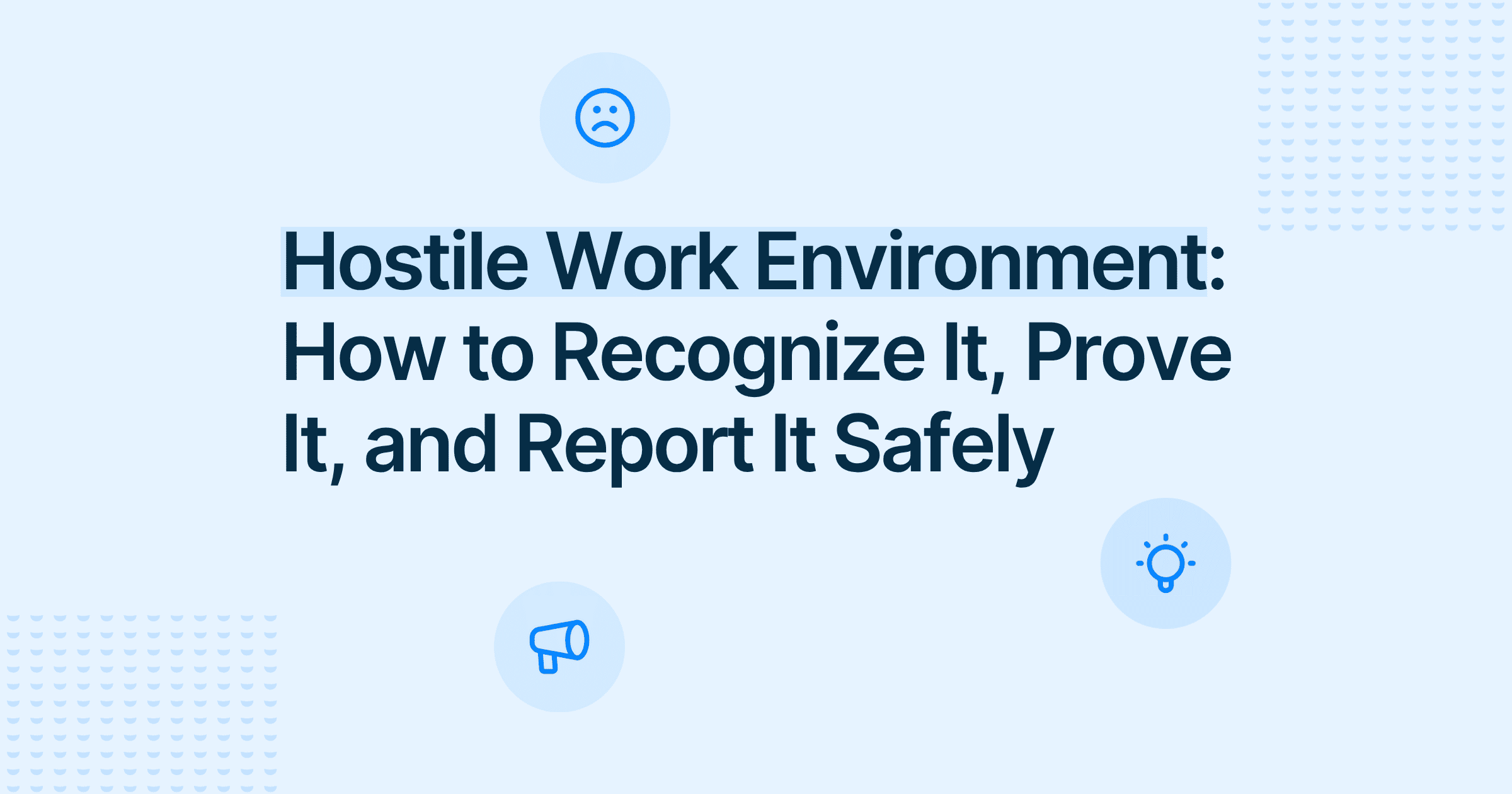




Workplace Environment

Alaa El-Shaarawi
Copywriter and Content Manager
Published
2025-10-10
Reading time
9 min


Table of contents
Subscribe to our newsletter
Work shouldn’t feel like walking through a minefield. Yet for many people, showing up means dealing with harassment, discrimination, or behavior that goes way beyond “bad vibes.” The hard part is knowing when it crosses the legal line, and how to speak up without putting yourself at risk.
At FaceUp, we believe that knowledge combined with the right tools gives employees the confidence to act. That’s why we provide guidance, checklists, risk assessment tools, and secure reporting features, so anyone experiencing workplace hostility can speak up without fear.
We're unpacking what a hostile work environment really means, how to recognize the signs, and what you can do to protect yourself or your team. You’ll also see how FaceUp’s anonymous reporting tools make it easier to speak up safely and take action before things escalate.

The U.S. Equal Employment Opportunity Commission (EEOC) defines a hostile work environment as ongoing or severe behavior that intimidates or abuses, especially when tied to protected characteristics. These include:
Think repeated workplace harassment, discriminatory jokes, unwelcome conduct, threats, or sabotaging someone’s work performance. These aren’t just cultural issues, they can break federal law under statutes like Title VII of the Civil Rights Act.
Even if the behavior doesn’t yet meet legal thresholds, patterns of workplace misconduct often escalate if unchecked.
Toxic and hostile workplaces aren’t the same, but they’re connected. Toxicity, such as favoritism, gossip, or poor management, may not break the law, but it erodes culture and often sets the stage for hostility.
| Toxic Workplace | Hostile Work Environment |
| Cultural/subjective | Legal/protected under federal law |
| Gossip, favoritism, poor leadership | Harassing conduct, unwelcome sexual advances, discrimination |
| Morale and culture | Conditions of employment, work performance, potential lawsuits |
| Management interventions, culture improvements | Required action, HR involvement, possible EEOC or legal action |

FaceUp helps organizations prevent escalation with culture assessments, feedback collection, and early intervention checklists, so legal issues never get a chance to develop.
See how to catch early warning signs before they spiral in our toxic workplace culture guide.
It’s not always easy to tell when something has crossed the line. One isolated incident doesn’t usually count, but repeated, targeted, or extreme incidents that would offend a reasonable person do.

Red flags to watch for:
Sometimes, hostility starts small. Gossip, favoritism, or blurred boundaries, like inappropriate fraternization at work, may not seem like much at first, but can create tension and escalate into something harder to ignore.
A hostile or abusive work environment doesn’t just affect the person experiencing it. It drags down the whole team and the organization. Ignoring harassment, discrimination, or unwelcome conduct tied to protected characteristics can have serious consequences:
Example: A company that dismisses repeated sexual harassment complaints ends up facing multiple EEOC claims, high staff turnover, and a public lawsuit costing millions in settlements and reputational damage.
When it comes to proving hostility, details matter. A vague account is easy to dismiss, but a documented record is much harder to ignore.
What to collect:
This might feel like a lot to manage, which is why we created the Harassment Investigation Checklist. If you’re unsure about what counts as reportable harassment or how to organize it, our guide on how to report harassment explains exactly what to do.
Proving hostility means showing more than “my workplace is bad.” You need to connect the dots:
This is where documentation and witnesses become powerful. Many cases fall apart not because the hostility wasn’t real, but because the evidence wasn’t strong enough. Using FaceUp’s reporting tools creates a timestamped, reliable record that’s hard to dispute.
Example: Keeping a log of emails where a coworker repeatedly mocks your sexual orientation or sabotages your work is critical to proving the hostile environment.
Even when people know they’re experiencing hostility, many stay quiet. The fear is real: losing your job, being pushed aside, or becoming a target. Add in unclear company policies or the worry that you won’t be believed, and silence feels safer.

That’s why FaceUp exists: to give employees a safe, confidential way to raise concerns. With anonymous reporting, they don’t have to choose between their safety and their voice.
Speaking up can be intimidating, but you don’t have to navigate it alone. Knowing your options and having a clear path can make all the difference. Here’s how to take action safely:
Sadly, retaliation still happens, even though it’s illegal. The best protection is being prepared.
When companies don’t take appropriate action, problems often surface later as the very issues whistleblowers report. Speaking up early can prevent bigger fallout.
From a legal angle, hostile work environment claims depend on whether the employer failed to act once they knew (or should have known). And yes, you can sue even after quitting. But it’s harder, because courts may ask why you didn’t try reporting internally first.

Deadlines matter too. In the U.S., you typically have 180–300 days to file with the EEOC. In the UK, it’s usually three months for tribunal claims. Elsewhere, timelines differ, but the clock is always ticking.
The emotional cost can be just as heavy. Anxiety, stress, and burnout are common when people endure hostility for too long. Legal rights matter, but so does your mental health.
FaceUp helps organizations maintain psychological safety and stay legally compliant through an anonymous way to report, track, and resolve incidents before they escalate.
If you’re in the U.S., it helps to know the laws that protect against hostile workplace environments. The EEOC enforces these, and understanding them gives you a clear picture of your rights and the company’s responsibilities:
| Law | Coverage |
|---|---|
| Title VII of the Civil Rights Act | Harassment or discrimination based on race, color, religion, sex (including pregnancy, sexual orientation, and gender identity), and national origin. |
| Age Discrimination in Employment Act | Harassment or discrimination against employees 40+ based on age. |
| Americans with Disabilities Act | Harassment of employees with disabilities and requirement for reasonable accommodations. |
| Genetic Information Nondiscrimination Act | Discrimination based on genetic information. |
| Whistleblower Protection Act | Retaliation against federal employees reporting unlawful activity. |
Breaking these laws can have serious consequences for employers: lawsuits, fines, damaged reputation, and loss of trust among employees.
FaceUp helps companies stay on the right side of the law by:
Employees often feel the impact of a hostile workplace first, but HR, managers, and compliance teams are the ones who can stop it from getting worse.
Don’t wait for formal complaints. Pay attention to what’s happening day to day: subtle exclusions, tension in meetings, or repeated anonymous reports. These are often the first signs that something’s wrong.
When someone raises a concern, follow up fast. Document what you find, stay neutral, and keep it confidential. The way HR handles one case often decides whether others will feel safe to speak up next time.
When possible, share what’s being done. Update policies, talk about changes, and remind people that retaliation won’t be tolerated. Trust builds when employees see that words lead to action.
Train managers to spot early signs of hostility and to intervene before things spiral. Keep your training current and your people informed, not just to stay compliant, but to keep everyone safe.
When HR acts early and communicates clearly, workplaces stay safer, stronger, and more human.
That’s what FaceUp helps make possible: a space where people can speak up and where HR can act with confidence and care.

The earlier you act, the easier it is to stop problems from spiraling. With FaceUp, you have tools to protect yourself and push for change:
Work should be a place of respect, not fear. And your voice matters. FaceUp is here to make sure it’s heard safely.
A hostile workplace isn’t just a bad day. It’s a threat to your dignity, your rights, and sometimes even the law. The earlier it’s caught and addressed, the easier it is to stop it from taking over.
Employees need safe ways to speak up. HR and managers need to see the warning signs and act before small problems become serious. When everyone does their part, the workplace can actually feel safe, fair, and respectful.
FaceUp makes that simple: anonymous reporting, clear tracking, and full transparency. When people trust the system and leadership responds, fear doesn’t run the office. Respect does.
Speak up. Step in. Build a better culture. Book your FaceUp demo today.





Keep Reading

Alaa El-Shaarawi2025-11-247 min
Employee Relations

Marie Roland2025-11-205 min
Whistleblowing

Alaa El-Shaarawi2025-11-195 min
Workplace Environment

Alaa El-Shaarawi2025-11-198 min
Legal & Compliance